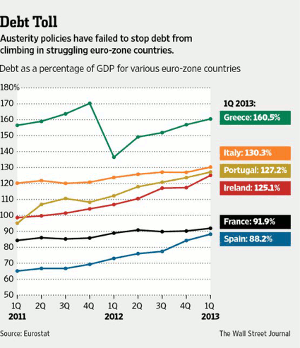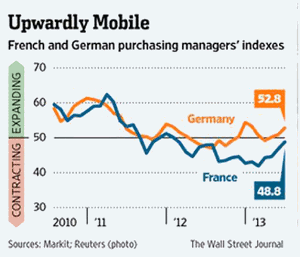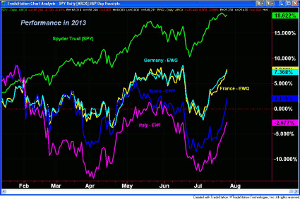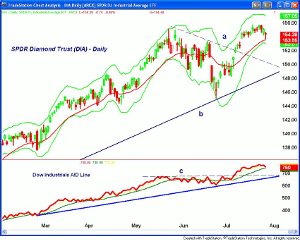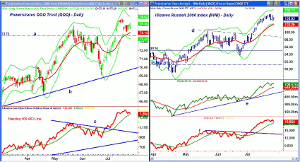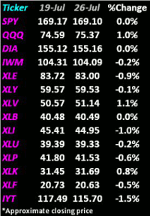The stock market continues to climb a wall or worry as it notches one all-time high after another, and MoneyShow’s Tom Aspray says that negative news from the Eurozone during this week’s heavy economic calendar could be just what the market needs to keep the rally going.
It was a heavy weak of earnings with wild after-hours trading as analysts digested the earnings reports. For example in the first ten minutes after Amazon.com (AMZN) reported its earnings on Thursday, the stock ranged from down $18 to down just $4.
Overall, over 70% of the companies have beat their earning’s estimates and just over 53% have beat on revenue. The earnings beat, so far, is the best since 2006 and was by far the best reading since the end of the bear market. Weaker revenue numbers have been a concern of many analysts and investors. The revenue has been in a gradual downtrend since the 4th quarter of 2009.
The best news last week came from Facebook, Inc. (FB) whose earnings surprised everyone as its stock gained 22% the day after its earnings were released. In this week’s trading lesson, I took an in-depth technical look at five of the tech giants. The market has not been kind to those that missed earnings as Expedia Inc. (EXPE) lost 22% on the opening Friday.
I also reviewed one of the tech industry groups that has been leading the market higher. It has clearly been a stock picker’s market as the market-tracking ETFs have not allowed many good risk/reward entry points.
My current concern for the stock market is what I see as the longer-term bullish outlook from many analysts. It is not that I disagree with them, but it is not a positive sign for the near-term market outlook. The periodic weaker-than-expected economic news has not dampened the enthusiasm but maybe the Eurozone will again shake up the market before the summer is over. Some negative news from the Eurozone could increase the bearish sentiment enough to fuel another phase in the market’s rally.
The recent efforts by Germany to push their austerity plans fell on deaf ears at the recent economic summit as the majority of the Eurozone, including France, believes that more attention should be paid to economic growth.
The table above demonstrates why Germany is concerned as Greece’s debt is over 160% of its GDP—with Italy, Portugal, and Ireland all over 100% of their GDP, as well. France and Spain are not far behind either. I have favored the stimulus path as the disastrous austerity push in 1936-1937 clearly postponed the economic recovery. I discussed this period in depth last fall Austerity Didn't Work in '37...What About Now?.
Of course, I think more could still be done, especially to save the crumbling infrastructure as I fear future disasters will make it clear that this problem needs to be addressed. The US debt level has gradually improved as the economy has become stronger. A growing economy is the fastest way to reduce debt.
There has been some improvement in the economic data from the Eurozone as last Friday’s data on Spain’s unemployment was an encouraging sign. Even better was the purchasing managers data on the Eurozone, which moved above the key 50 level. Germany’s data was even better as after dropping below 50, it rose sharply to 52.8, and France also showed nice improvement.
The business sentiment in Germany, Belgium, and the Netherlands also perked up as Germany’s business confidence improved in each of the past three months. Italian consumer confidence hit its highest level in over a year.
This has given some of the Eurozone stock markets a boost as they had been under pressure for the first half of the year. The % Performance chart for 2013 shows that the iShares MSCI Italy ETF (EWI) was down almost 14% for the year in early April, but now is just down 3.6%.
The ETFs that follow Germany (EWG) and France (EWQ) are now up 7.3% and 6% respectively while Spain (EWP) has just moved back into positive territory. It was down close to 9% at the start of the month. All are trailing the 18.2% gain in the Spyder Trust (SPY).
Despite these signs of improvement, a shock from the Eurozone is still possible, and next week the Federal Reserve, European Central Bank, and the Bank of England are all meeting. Though nothing substantial is expected from the meetings, a surprise is always possible.
NEXT PAGE: What to Watch
|pagebreak|Several of last week’s economic numbers beat expectations as the flash Purchasing Managers Index showed nice gains, and the Durable Good Orders were also much higher due to airplane orders for Boeing (BA). The final reading on consumer sentiment from the University of Michigan was released on Friday and at 85.1 was better than expected
The monthly jobs report is out this Friday, and there is a full slate of economic data this week starting with Pending Home Sales and the Dallas Fed Manufacturing Survey on Monday.
There is more housing data on Tuesday with the S&P Case-Shiller Housing Price Index. The FOMC also starts its meeting and the Conference Board releases its latest data on Consumer Confidence.
The data on Wednesday may set the tone for the whole week as we get the advance reading on the 2nd quarter GDP, the ADP Employment Report, the Chicago Purchasing Managers Index, and the FOMC announcement.
Besides the jobless claims on Thursday, we also get the ISM Manufacturing Index, which sets the stage for Friday’s monthly jobs report. The end of the month adjustment of positions and the full slate of economic data should keep volatility fairly high.
What to Watch
The flat close in the S&P 500 and the Dow Industrials last week was due to the rally late Friday, which brought these averages back to positive territory. The market internals on the NYSE were decidedly negative on Friday. This has weakened some of the A/D indicators, and we still may see a deeper correction as we head into the end of the month. There are no strong sell signals yet, but they may develop this week.
The typical short-term seasonal trend I discussed on June 21 indicated that July would be a better month for stocks. The pattern is also for the market to turn lower at the end of the month and then develop a trading range in August. Given the impulsive rally from the June lows, the pattern may be different this year.
This means that August may be a difficult month for many investors, but those that bought near the recent highs as I discussed last week, may already have some regrets. A further correction should be an opportunity to establish positions in some of the regional banks, as well as the homebuilders, which dropped last week. These stocks are likely to move even lower before their major up trends resume.
A further correction will help to turn the overall sentiment of both the professional investors and the public more negative. The public outlook for the economy is still quite negative as a recent survey by Rutgers University found that 54% of Americans believe the economy will take six to 10 years to recover or will not fully recover from the Great Recession.
This means that a much smaller percentage of the public is invested in the market than they were in the late 1990’s. Those who are investing, like those in the AAII survey, are still too bullish at 45%, even though this is down from 49% in May. The financial newsletter writers are also too bullish at 51.5%, up from a reading of 41.7% on June 26. The number of bears at 19.6% is also too low.
NEXT PAGE: Stocks
|pagebreak|The daily chart of the NYSE Composite shows that while the S&P 500 and Dow Industrials were making new highs last week, it failed to surpass the May high at 9695.46, line a. There is minor support now at 9443-9462 with the 20-day EMA at 9474.
The quarterly pivot is at 9251, and if last week’s high was a short-term top, then the 38.2% Fibonacci retracement support is at 9348 with the 50% support at 9242. This also corresponds to the 20-week EMA at 9237.
The McClellan oscillator, which formed multiple positive divergences at the recent lows, line b, has been diverging as prices moved higher. The drop below the zero line, Friday, confirms the short-term negative divergence and does allow for a further decline.
The daily NYSE Advance/Decline line did not surpass the May highs last week and is now testing its still-rising WMA. It is still well above the support at line c, while the June lows are a more important area of support.
S&P 500
The Spyder Trust (SPY) tested the monthly pivot resistance for the first three days of last week before turning lower. This was the weakest weekly close in the past five weeks, suggesting the rally has lost momentum. The rally from the April lows also lasted four weeks and was then followed by a five-week correction.
There is next support at $167.07 and then at the 20-day EMA at $166.75. The mid-June high was at $166.12, with further support in the $162-$164 area.
The on-balance volume (OBV) turned positive in late June and early July when it moved through its WMA and the downtrend, line d. The OBV has failed to make new highs with prices and this divergence, may be warning of a deeper correction. The OBV has strong support at line e. The weekly OBV is still locked in its trading range and is above its WMA.
The daily S&P 500 A/D made new highs last Monday and has now dropped back to its rising WMA. The WMA could fatten out this week before it is ready to decline. There is initial resistance for SPY in the $168.75-$169.20 area.
Dow Industrials
The SPDR Diamond Trust (DIA) failed to make new highs last week with the Dow Industrials as the high at $155.70 was just below the prior week’s high at $157.74. The flat weekly close has weakened some of the momentum studies as the 20-day EMA at $153.55 was tested on Friday.
The former downtrend, line a, is now in the $150 area with the longer-term up tend, line b, in the $149 area. The key support from late June is at $145.17.
The daily Dow Industrials A/D line broke through the May-June trading range, line c, in early July, and made significant new highs this month. Another new high was made last week though it has now turned lower.
Nasdaq-100
The PowerShares QQQ Trust (QQQ) did much better last week after absorbing the losses from Google, Inc. (GOOG) and Microsoft, Inc. (MSFT) the prior week. Unlike SPY or DIA, it closed the week almost 1% higher as it held above the 20-day EMA at $74.13 and the support at $73.70, line a.
There is additional support now at $72-$73 with the 20-week EMA at $71.83. The quarterly pivot is at $71.03.
The Nasdaq-100 A/D line was stronger than prices last week as it made a new high before turning lower late in the week. The A/D line is still holding above its WMA as it staged a powerful breakout above resistance, line c, in late June.
There is first resistance for QQQ at $75-$75.54 and monthly pivot resistance at $76.08. The weekly starc+ band is at $77.42
Russell 2000
The iShares Russell 2000 Index (IWM) was down a bit for the week as its rally stalled just below $105. The daily starc+ band is now at $106.15 with the quarterly R2 resistance at $106.65.
The daily OBV did confirm the recent highs and is holding well above its WMA and long-term support at line e. The weekly OBV also made new highs, so both OBV time frames are positive.
After breaking out of its trading range, the Russell 2000 A/D line has continued to act strong as it did make a new high with prices and is holding above its WMA.
The rising 20-day EMA is at $102.25 with the daily starc band. There is further support in the $100.38 to $101 area with the quarterly pivot well below current levels at $95.50.
NEXT PAGE: Sector Focus, Commodities, and Tom's Outlook
|pagebreak|Sector Focus
The iShares Dow Jones Transportation (IYT) made new all-time highs at $117.96 on July 17 before reversing. It was down 1.5% last week and hit next support in the $113.50 area. The quarterly pivot is at $110.98 with the monthly pivot at $110.68.
The weekly relative performance reversed to the downside last week after appearing to move through resistance. The daily RS line is locked in a trading range. The weekly OBV has confirmed the new highs but the daily has not.
Just three of the 14 ETFs I normally track for the Week Ahead column finished the week higher. One of my favorite hot sectors, the Select Sector SPDR Health Care (XLV) made another new all-time high and led the way gaining 1.1% for the week.
The Select Sector SPDR Technology (XLK) and PowerShares QQQ Trust (QQQ) also showed decent gains for the week, yet the relative performance analysis for the tech sector has still not turned positive.
The Select Sector SPDR Energy (XLE) needed a strong close to suggest it was starting to be a market leader but instead closed down 0.9%. The Select Sector SPDR Industrials (XLI) showed a similar loss.
The Select Sector SPDR Consumer Discretionary (XLY) traded in a tight range last week and is holding up very well.
Interest Rates
Both the yield on the 30-year T-bond and the 10-year note closed the week higher as yields spiked higher early in the week before drifting lower. The technical patterns still look corrective (lower yields), but the 10-year needs to drop below 2.460% to confirm.
Crude Oil
Crude oil hit a high of $108.83, basis the September contract on Friday July 19 and then dropped over $4 per barrel last week. The chart shows that the quarterly R2 resistance had been exceeded just before prices turned lower.
The daily and weekly technical studies are positive as the OBV is well above its rising WMA. The 38.2% Fibonacci retracement support from the June lows is at $102.31 with the 50% support at $100.27.
There is initial resistance now at $107.50 and as I mentioned in the yearly analysis the key resistance is at $110.55.
Precious Metals
The gold futures and in the Spyder Gold Trust (GLD) both closed the week higher but ended near the week’s lows. This still looks like a ‘bull trap,” which is a rally that is strong enough to encourage new buyers but then is followed by another decline.
I discussed this in detail last week but the OBV has just rallied back to resistance at line b. The chart shows that there is major price resistance, line a, in the $132 area.
The Week Ahead
The stock market closed barely higher on Friday and flat to higher for the week with the Nasdaq 100 leading the way. Though the selling was fairly heavy early Friday, the market was once again well supported.
The Dow Industrials made new all-time highs again last week but the other major averages did not. Maybe the gradual pullback has been enough to set the stage for another push to the upside, but I am not convinced. If you do the risk analysis like I did last week, it is still a better idea to be patient and wait for a better entry level in the market-tracking ETFs.
For those in the bond market, the spike last week was a concern, but I still think bonds can correct further in the next few weeks. If your portfolio is entirely weighted to the long end of the curve, then I would start to adjust now in case we do not see lower rates.
For those who are not invested in stocks, this is a great time to start a dollar cost averaging program in either a low-cost fund or in an ETF where you do not have to pay commissions. Decide how much you want to invest in total and then break it into five equal parts. Invest the first on August 12 and then equal amounts every two weeks. This will make you fully invested by early October, which is the start of a seasonal strong period.
Don’t forget to keep an eye on my Twitter feed as I will often Tweet my new recommendations before the opening.
- Don't forget to read Tom's latest Trading Lesson, An In-Depth Look at 5 Tech Giants.

